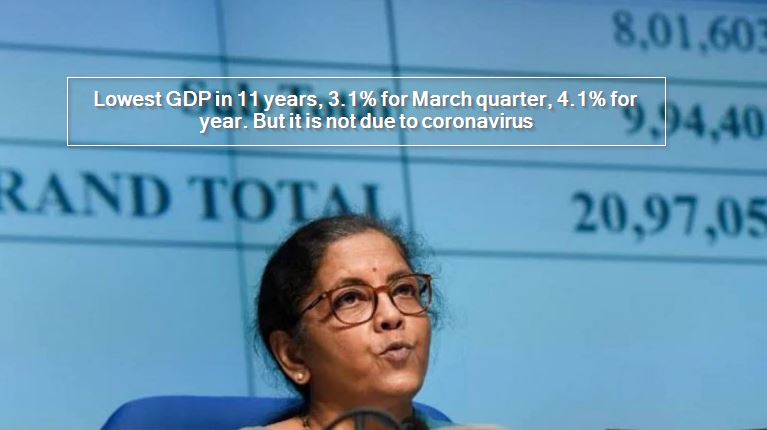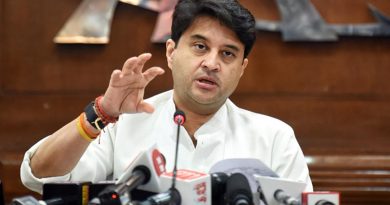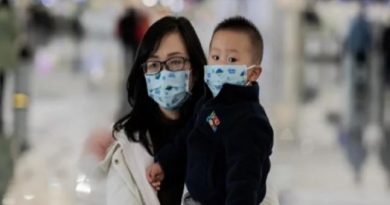Lowest GDP in 11 years, 3.1% for March quarter, 4.1% for year. But it is not due to coronavirus
GDP growth rate for March quarter slipped to 3.1% from 4.7% recorded during the previous quarter. The economy grew by 4.2% in 2019-20 for year. The coronavirus lockdown will have more impact in June quarter.
he government on Friday announced GDP growth figures for the fourth and final quarter of 2019-20 ending March. At 3.1 per cent, the GDP growth has exceeded the range of what experts had predicted: 0.5 per cent to 2 per cent. But it is over 1.5 percentage points lower than the GDP growth rate for the previous quarter.
The GDP growth rate for whole 2019-20 stood at 4.2 per cent. It is almost 2 percentage point lower than the revised GDP growth rate of 6.1 per cent for 2018-19. This is also the lowest annual GDP growth rate in 11 years.
The GDP figures are actually an expression of an extended economic downturn that India had been witnessing for seven quarters before coronavirus pandemic brought growth almost to a halt. India recorded its first coronavirus cases in January-end but that was not the outbreak, which happened in the first week of March.
The businesses were not yet under a serious attack in India as the coronavirus situation was still unfolding in India and elsewhere in the world. It was only the final week of March that India went for total lockdown: from March 25. That is, only a week of the previous financial year was impacted by coronavirus. It is but a minor contributor to India’s economy.
At 4.7 per cent, the GDP growth rate for December quarter was bad news. The government was already in action trying to right the economy’s ship. Finance Minister Nirmala Sitharaman announced a slew of measures in August, September and November last year, and March this year besides the two Union budgets in July 2019 and February 2020.
[amazon box=”B0746LNLQF” “small”]
Still, the economy failed to gather itself. Only the May announcement of special Covid-19 package worth Rs 21 lakh crore has been made truly in the shadow of coronavirus.
So, the March quarter GDP figures tell that coronavirus could not have hit India at a worse time. India’s economy was on its way to bottom out.
The official data for core sectors in April give an indication of what may in store. The output of eight core infrastructure industries shrank in April – when coronavirus lockdown was in full force — by a record 38.1 per cent.
Coronavirus lockdown of 40 days and then graded lifting means the bottoming out of India economy has prolonged.
The coronavirus economic crisis bears an uncanny similarity with the 2008 global meltdown and its impact on India.
In 2008, India had found its GDP growth going down and fiscal deficit suddenly jumping by 250 per cent. A SBI research paper recently apprehended a similar ballooning of fiscal deficit to 7.9 per cent in the wake of special Covid-19 package.
For a better perspective, a small back-story of the 2008 economic package.
GDP growth rate started declining from March 2008 quarter and continued over the next two quarters. Like today, private consumption was declining and causing the fall in GDP growth numbers.
The situation suddenly looked much bleaker after September 2008 when Lehman Brothers filed for bankruptcy in the US. In India, it set off panic in the government and economy. It was not unfounded. India recorded 5.6 per cent growth rate, which was a big fall given the robust numbers of the previous years.
The government announced three economic packages between December 2008 and February 2009 of a total worth of Rs 1.86 lakh crore or about 3.5 per cent of GDP.
The RBI, like today, took measures to push additional liquidity worth Rs 5.6 lakh crore or about 9 per cent of the GDP. These measures were hoped to boost private consumption once again, which actually happened but at the cost of burgeoning fiscal deficit that reached almost 6.5 per cent of GDP.
Many experts believe it was a mistake to have the kind of economic package that the government came up with in 2008-09. It kept India busy over the next several years worrying about fiscal deficit more than anything else. Fiscal deficit finally came under control in 2015-16/206-17. But after that, crude oil prices which helped India bridge the gap, started rising again before coronavirus pandemic flattened all demands.
The latest GDP growth figures, combined with the special Covid-19 package mean that the worst in India economy did not get over in March.
The government has been criticised over special Covid-19 package for not attempting cash transfer – in a more direct manner than 2008-09 – but a cautious approach may turn out to be a good move for India’s economy. But the government will have to address the money problem of the migrant labourers and daily wagers. How? Nobody seems to know.




